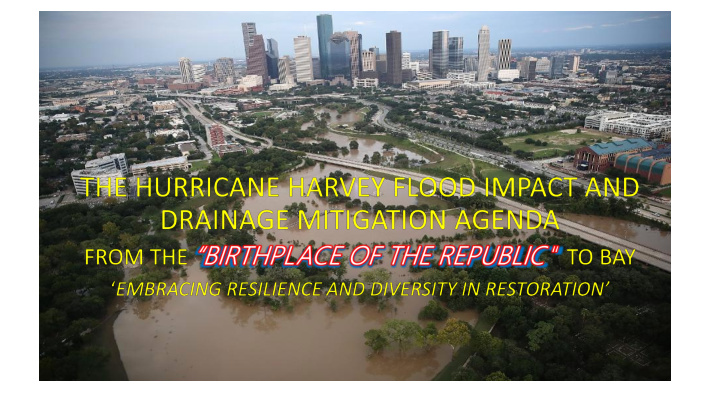



Executive Summary • The City of Pasadena Drainage and Flood Mitigation Program (Drainage Program) has been established as a benchmark for protection of the National Flood Insurance Program (NFIP) and the lives of all citizens affected by flooding events. This Drainage Mitigation Agenda presented herein focuses on Equity for accommodation of notable Social Vulnerability Indices (SVI) and Low to Moderate Income (LMI) areas in and outside the 100 Year floodplain. Both groups generally hold lower Benefit Cost Ratios and need advocate support to promote critical restoration. • Potential Governmental Advocacy Bodies and Beneficiaries: State of Texas US Army Corps National Flood Federal Emergency Harris County Flood Control of Engineers Insurance Program Management Agency District Harris County Piney Point Village Pasadena Nassau Bay US Gross Domestic Product Galveston County Hunters Creek Village Deer Park League City As Well As: City of Houston Spring Valley Village South Houston Dickinson Barker Cypress Subdivisions Jersey Village Hilshire Village Pearland NASA Edgebrook Subdivisions Hedwig Village Galena Park Friendswood Port of Houston Sagemont Subdivisions Bunker Hill Village Jacinto City Webster Multiple Critical And more… Industrial Complexes
Considerations • A consideration of historic regional impact is subsidence due to groundwater use for potable water supply. • The Harris Galveston Subsidence District indicates that, prior to transfer to surface water treatment for potable purposes during the 20th century, the Harris County region experienced 2-9' of subsidence creating the identification of a 500 Year floodplain.
Se Secondary Consideratio ions – A ‘Good Neighbor Policy’ This Drainage Mitigation Agenda developed through a keen awareness of the need for a Good Neighbor Policy towards regional drainage plans that allow for the study of projects like Connector Tunnels that consolidate White Oak, Buffalo, Brays and Sims Bayous at/or below the Houston Ship Channel Turning Basin.** Please note the Ship Channel Cities are not cited or shown in this planned study. ** Drawing Excerpt from Freese and Nichols White Paper “Tunneling – An Innovative Approach to Moving Stormwater ” presented by Brian Gettinger, PE (brian.gettinger@freese.com)
1940 South Canal Solution Current Super Tunnel Study Limits
“HARRISBURG - BIRTH THPLA LACE E OF THE REPUBL UBLIC “
FINAL CONSIDERATIONS: • Generally, two types of storms impact the region. Wind Storms with surge and Tropical Storms with heavy rainfall. • The extension of the Harrisburg/Brady Island SH3 Diversion Tunnel responds to support USACE diversion control and mitigate impact to one of the largest industrial/chemical complexes in our Nation. • The SH3 route is inclusive to inter-governmental restoration efforts by providing a resource to protect the National Flood Insurance Program (NFIP) while reducing detention requirements and the decimation of buyouts. • The impact areas for the proposed alignment will provide substantial equity for SVI and LMI benefits to meet multiple funding source requirements. • The SH3 Diversion Tunnel will increase competition to bring more service providers and reduce overall markups in construction contracts. • The SH3 Diversion provides a comprehensive approach to realignment of the USACE proposed 1940 ‘South Canal’ and will garner more support from State and Federal partners. • The alignment can be supported with a Parallel Evacuation Route to IH 45 by creating a Toll Road from IH 610 to League City. This route is identical in dimension to the Westpark Tollway for evaluation purposes.
Ideas?
Recommend
More recommend